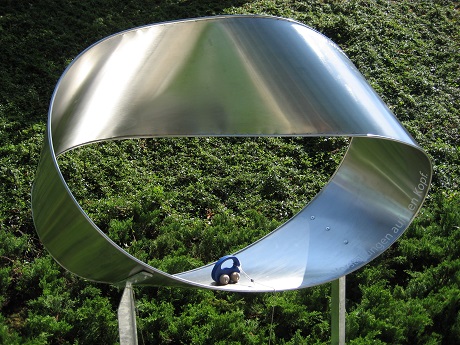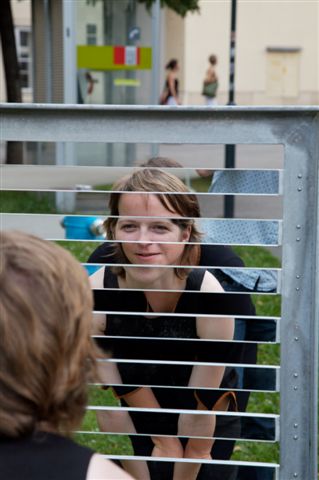Science Playground
The Science Playground with its combination of play and science is a symbol for the campus of the University of Vienna as a recreational area with an academic environment.
The Science Playground was built on the occasion of the tenth anniversary of the University of Vienna campus and opened on 11th July 2008 by Vice Mayor Brauner and Rector Winckler in a festive setting.
Eight objects in courtyard 7 of the campus of the University of Vienna invite children as well as adults to marvel, explore, reflect and discuss.
The Möbius Strip
Science turns ideas upside down
Everything has a front and a back, even the smallest cells or the largest planets. Normally! The so-called Möbius strip is a very special object that has an edge and a surface, but no inside and no outside and no back and no front. The Möbius strip is one-sided.
You don’t believe that?
Then try it out and be amazed. The Möbius strip is a symbol that it is very important in science not to be guided by what is normally true. Science sometimes turns ideas upside down.
Here a handicraft guide (German language only)

The prism
Science sharpening the view
If the sun shines on a prism the light is refracted and a piece of rainbow becomes visible. If you hold the prism in front of your eyes, coloured edges appear at every transition between light and dark. The so-called spectral colours become visible. The spectral colours cannot be further broken down; if all the spectral colours are combined, white light is produced.
Also in science one tries to break down the research object into its individual parts and also in science one is sometimes astonished about how manifold and colorful these individual parts can be.

The Trickleboard
Science creates structures
The trickleboard is filled with grains of different sizes. By turning the board, the grains trickle through the board as if you were turning an hourglass over. The grains, however, are of different sizes and trickle at different speeds. It can be observed that according to the rule “like to like”, bigger to bigger, heavier to heavier, layers are formed which are also visible in color.
The structure is the inner structure of an object, the way in which individual parts are connected to form a whole. In science it is also often a matter of finding connections and combining parts into a whole, i.e. structuring them.
This process also occurs in nature, for example in the formation of rock layers that have been formed over billions of years. Structures are formed.
Here you can find a mineralogy game website of the University of Vienna! (German language only)

The arithmetical trick
Science amazes
Science seeks and finds solutions to complex problems. Solving a mathematical problem can also bring amazing insights.
The arithmetic trick of the science playground can also be tried out in the virtual world!
And if you want the solution, maybe this formula will help you:
x = 1st digit
y = 2nd digit
10x + y – (x + y) = 10x + y – x – y = 9x
Is everything even more mysterious now?
The calculation trick could be realized thanks to the company BOC.

The magnifying benches
Science observes
Observation is an important instrument of scientific research. Observation takes time and a little patience, because sometimes you have to wait for what you want to observe. And it needs accuracy, because for science the observations have to be carefully documented and evaluated.
In research, you have to take a close look to discover something new, to find out something unusual, or to recognize special features. The magnifying glass is a symbol for this, because sometimes the naked eye is not enough to observe what you want to observe. If you want to observe very closely, you can do this with a magnifying glass, but you can also use other magnification options.
Did you know that a drop of water can be like a magnifying glass?
Try it out! Here you can see how it works: water drop magnifier (German language only)

The perspective chair
Science changes perspectives
The perspective chair – first presented by Jean Beuchet in 1963 – is astonishing in that parts that are separated from each other are seen by our eyes as belonging together.
The seat of the armchair is at a distance from the chair legs. But from a certain observation point, the parts appear as a whole armchair. Now when a person sits on the seat, we believe that this person is as close as the chair legs. But the person seems a little too small to us – because in reality he is further away.
In science it is very important to constantly change perspectives. This is the only way you don’t run the risk of being deceived.
Are you interested in optical illusions? Here is a link tip: http://www.michaelbach.de/ot/index-de.html
The perspective chair could be realized thanks to the company Stangl International.

The Talk Tubes
Science communicates
Even in ancient times, speaking tubes were used to be able to communicate at the speed of sound over distances that were too far for a normal conversation. Long before telephones existed, it was possible to communicate between floors in a house, for example.
Communication is the exchange of messages or information. Communication is an important part of scientific work.
Scientists communicate with other scientists to discuss scientific issues, but also with all the people for whom science is made.
If you want to make your own tube, try mug telephony and discuss your latest ideas with your friends!

The mirror bands
Science combines
Mirrors are reflective surfaces that create images. Mirrors have been around for 7000 years and allow us to take a look at ourselves.
With mirror bands you can create amazing images of yourself and your counterpart, funny image combinations are created.
New findings in science often result from the fact that things are combined that at first glance do not belong together at all.
What you can do with mirrors: mirror quiz

Idea and Concept: Vienna University Children’s Office
Execution of 6 objects: Mag. Peter Kermann, Decoration construction
Graphic design: Vlatka Nikolic Onea
We thank the sponsors of the science playground: Innovation Center University of Vienna GmbH, University of Vienna
